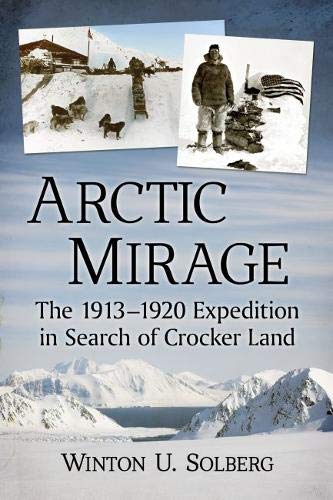Arctic Mirage: The 1913-1920 Expedition in Search of Crocker Land
Winton U. Solberg
 On explorer Robert Peary’s 1906 expedition, he looked out over the Arctic icescape and thought he discerned a large landmass to his northwest, one which he called Crocker Land after a major donor to his expedition. On his return and the publicization of his findings, the question of Crocker Land’s existence became an urgent one in Arctic-minded circles.
On explorer Robert Peary’s 1906 expedition, he looked out over the Arctic icescape and thought he discerned a large landmass to his northwest, one which he called Crocker Land after a major donor to his expedition. On his return and the publicization of his findings, the question of Crocker Land’s existence became an urgent one in Arctic-minded circles.
Winton Solberg’s Arctic Mirage covers the entire arc of the expedition sent to discover the reality or unreality of Crocker Land. This covers not just the difficulties and dangers of the expedition itself, but the work it took to get it together, the journeys out and home, and the aftermath. The attention paid to the institutional politics behind the voyage is one of the book’s valuable resources, showing not just the small-scale intergroup dynamics that shape the character and content of such an effort, but the larger-scale flows of money and prestige that bring it into existence in this particular form and shape how and by who it will be remembered afterward. One of the last chapters of the book, for instance, goes into detail about the troubled publication history of expedition leader Donald MacMillan’s geographical report—it was not published by the American Museum of Natural History until 1930, long after other expedition members (including MacMillan) had published narratives of their experience. Readers interested in the ecology of the polar regions will also be drawn in by extensive descriptions of polar flora and fauna, and how they were charted and described by members of the expedition.
What the book lacks at times is a certain degree of critical or analytical distance from its source material, so that at times the reader is jerked back and forth between different attitudes toward the people involved with little authorial guidance. On page 138, for instance, American Museum of Natural History curator of geology Edmund Hovey is “a tactless, impolite person” and on page 139 he is a “poor old man,” with no clear distance or distinction between whose points of view these are. This juxtaposition of perspective could be quite interesting, but it is not fully made explicit or analyzed and thus is often confusing.
Where this tendency becomes especially unfortunate is in the description of the Inuit. Solberg seems to take the Americans’ characterizations of them as fact, so in his prose they retain the “childlike” qualities attributed to them by the explorers. In Solberg’s own prose they are hysterical, sulky, superstitious; the Americans have to learn their “tricks” (p. 43). No attempt is made to move far beyond this framing, and later in the book expedition member Elmer Ekblaw’s screed on the racial characteristics of the “Polar Inuit” is paraphrased in long stretches as if it were pure fact. To his credit, though, Solberg treats expedition member Fitzhugh Green’s murder of accomplished Arctic guide Peeahwahto (Piugaattoq) with full seriousness, devoting an entire chapter to it, though it might perhaps be wished for this incident to be connected back to the meat of the expedition and the knowledge it attempted to produce.
On the whole, this is an in-depth and interesting narrative of the expedition in search of an unreal place, one which should however be read with a skeptical eye.
- Jefferson, North Carolina: McFarland, 2019
- 6” x 9”, softcover, vii + 255 pages
- Photographs, map, notes, bibliography, index. $35.00
- ISBN: 9781476638096
Reviewed by Brooke Grasberger, Brown University
